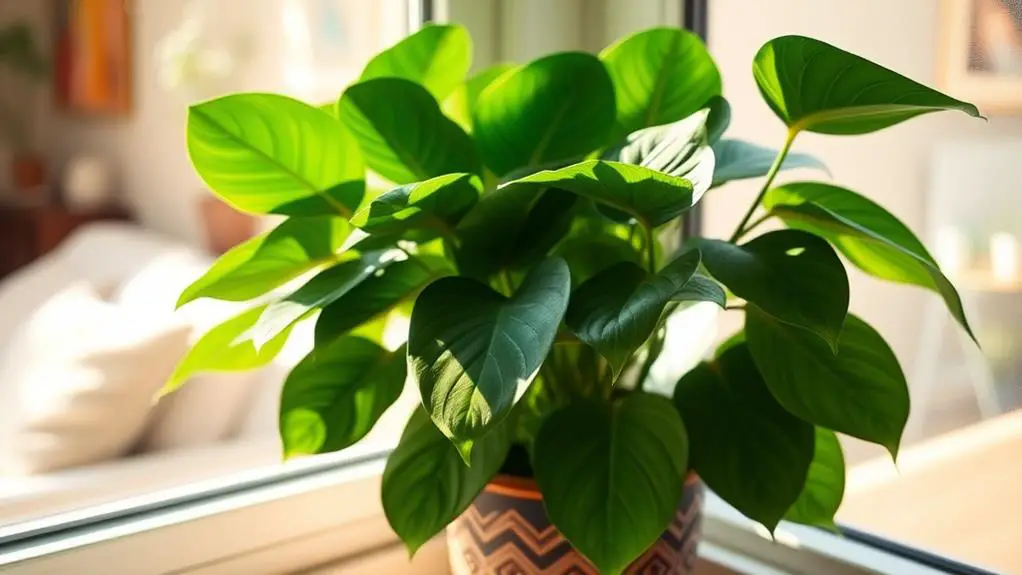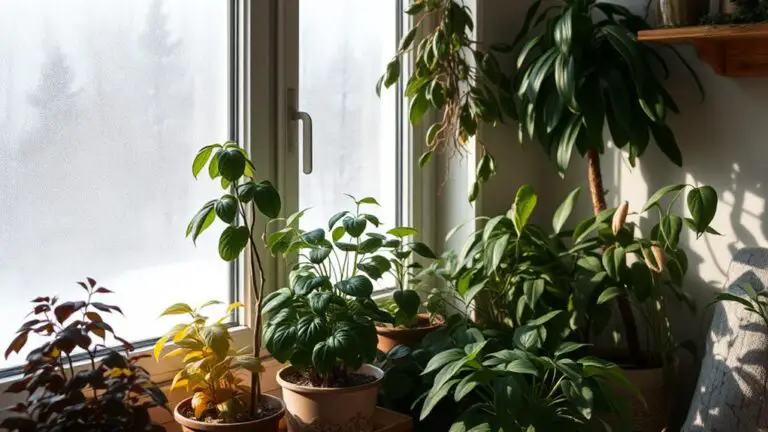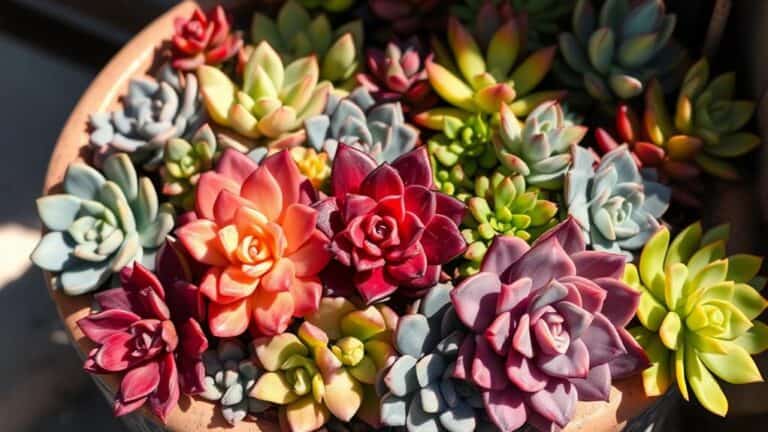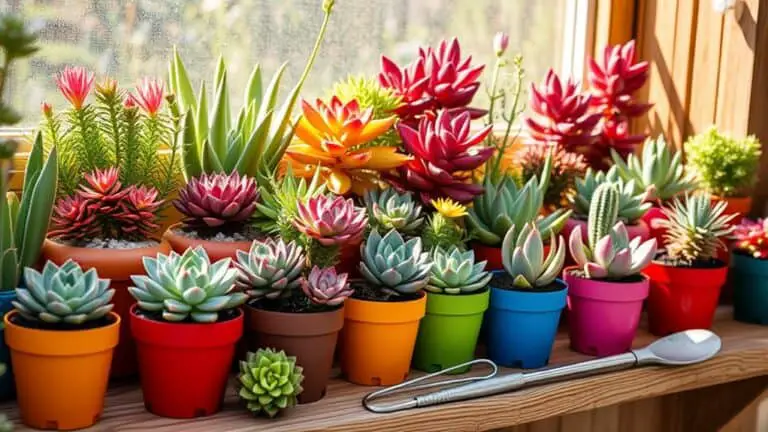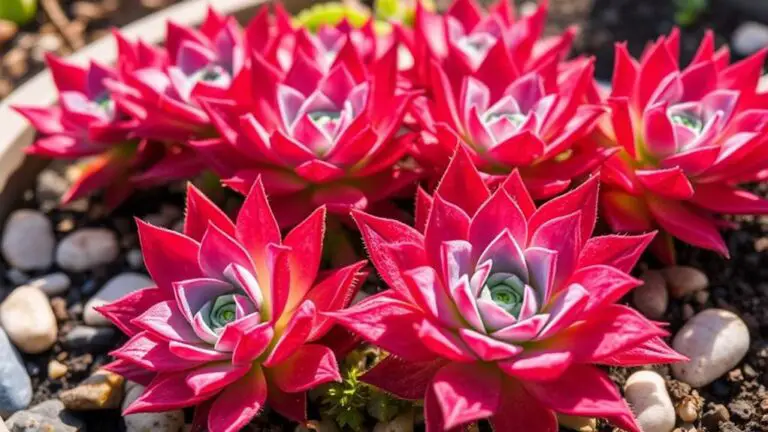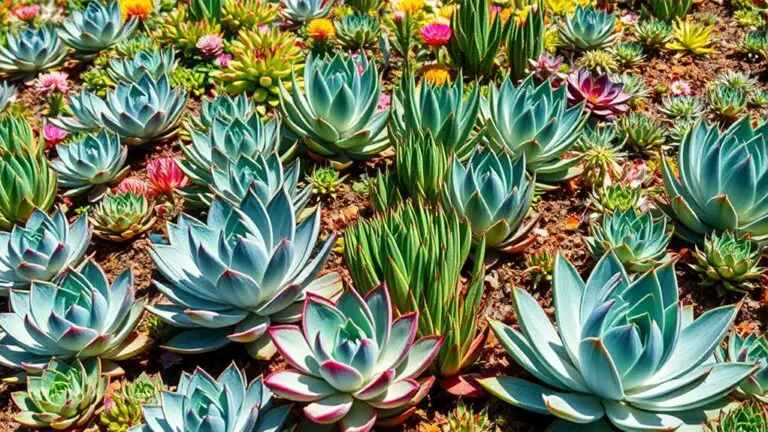5 Essential Tips for Thriving Philodendron Plants
If you want your Philodendron plants to flourish, you need to focus on a few essential care tips. Start by ensuring they get bright, indirect light and rotate the plant regularly to promote even growth. Proper watering is just as important—check the soil moisture and use room temperature water. Don't forget to fertilize every 4-6 weeks during the growing season with a balanced liquid fertilizer. Providing enough space and support structures will also help them thrive. Finally, remember to repot when needed, especially in spring, using a well-draining potting mix. Curious about each tip's specifics?
Optimize Light Conditions
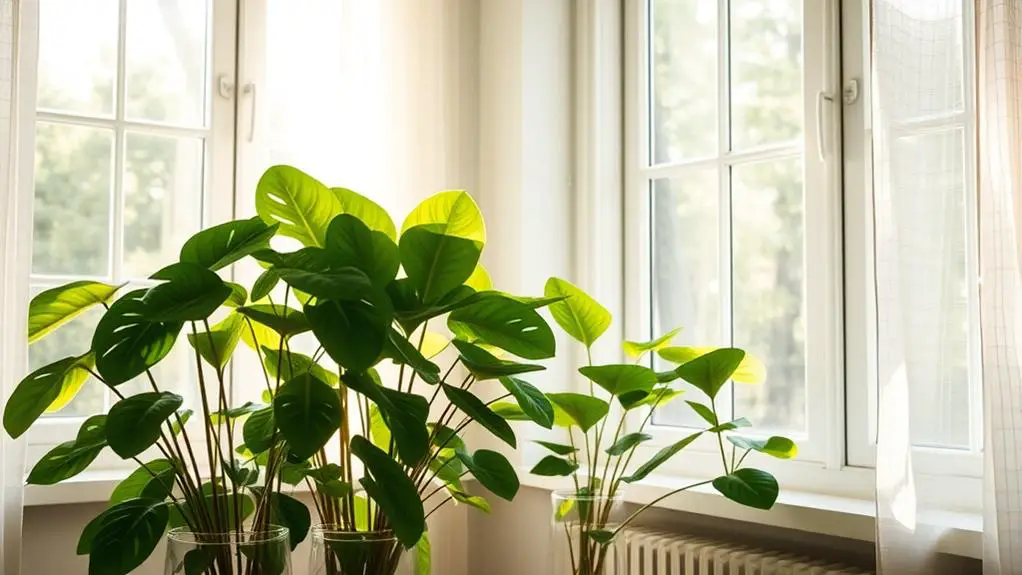
To guarantee your philodendron thrives, you'll need to optimize its light conditions. Philodendrons flourish best in bright indirect light, similar to their native habitats. Place your plant near a window where it can soak up plenty of filtered sunlight without being hit by direct rays. This setup helps keep your philodendron healthy and vibrant.
While philodendrons can tolerate low light, it's not ideal for their long-term health. Prolonged low light can cause leggy growth, making the plant look sparse and weak. To avoid this, make sure your philodendron gets enough bright indirect light. If you notice your plant stretching towards the light, it might be a sign to move it closer to a brighter spot.
Direct sunlight can be harmful, causing leaf burn and permanent damage. Keep your philodendron away from windows that get strong, direct sun.
Also, rotating your plant every few weeks is essential. This guarantees even light exposure and prevents one side from growing unevenly.
Lastly, keep an eye on how your plant responds to changes in light. Adjust its placement as needed to maintain its vibrant health. By following these tips, your philodendron will thrive beautifully.
Master Watering Techniques
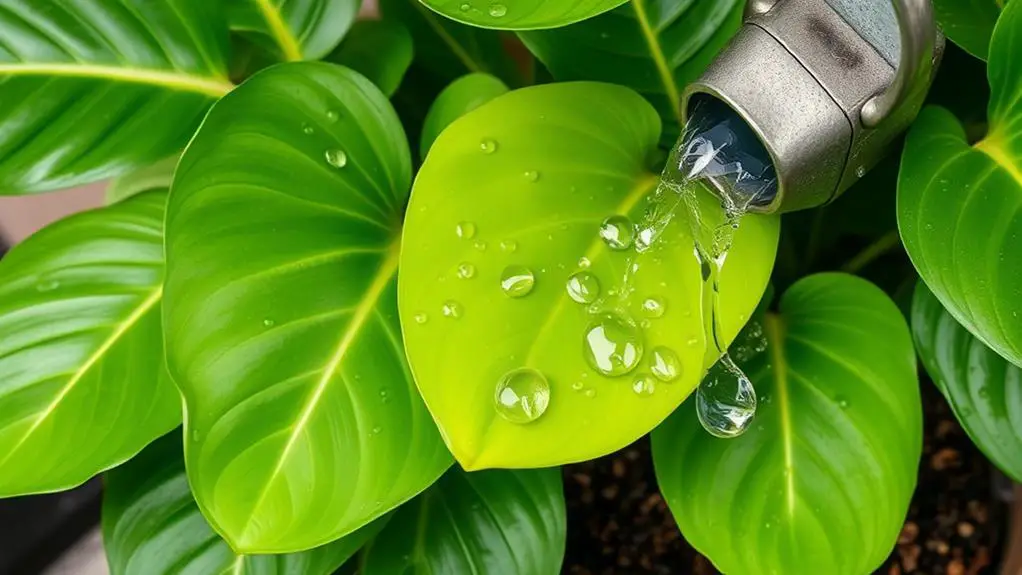
Having optimized your philodendron's light conditions, it's equally important to master its watering techniques. Start by watering your philodendron when the top inch of soil is dry to the touch. This guarantees the plant gets the moisture it needs without the risk of overwatering.
Always water thoroughly until excess water drains from the bottom of the pot. This promotes healthy root growth and prevents root rot, keeping your plant healthy and happy.
Use room temperature water, as cold water can shock the plant and hinder its ability to absorb moisture. Adjust your watering frequency during the winter months since the plant's growth slows down due to lower light levels. This means you'll need to water less often than in the warmer months.
Regularly checking the soil moisture is essential. If you notice drooping leaves, it could be a sign of either underwatering or overwatering. Take a closer look to determine the cause.
Fertilize Wisely
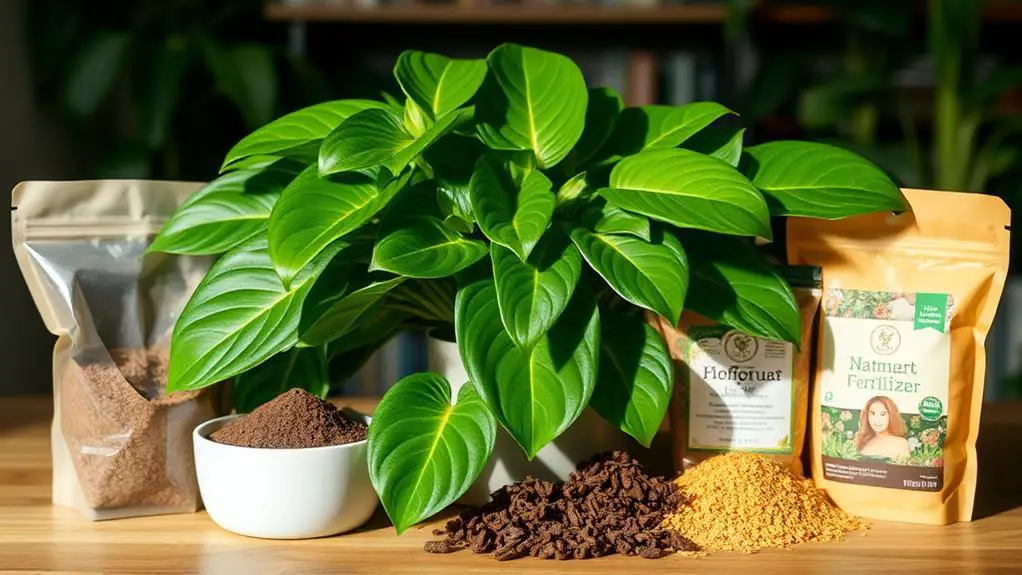
Fertilizing wisely is vital for maintaining your philodendron's lush foliage and robust growth. During the growing season in spring and summer, you should fertilize your plant every 4-6 weeks.
Use a balanced liquid fertilizer to provide the nutrients your philodendron needs for healthy growth and vibrant leaves. Always remember to dilute the fertilizer to half-strength to avoid root burn and guarantee ideal nutrient uptake.
As fall and winter approach and your philodendron's growth slows, reduce the fertilization frequency to every 6-8 weeks. It's important to avoid fertilizing during the dormant period in winter to prevent nutrient buildup, which can harm your plant.
Pay attention to the size of new leaves; if you notice they're smaller than usual, it could indicate a nutrient deficiency. This means your plant might need a little boost from fertilization.
Allow Room to Grow
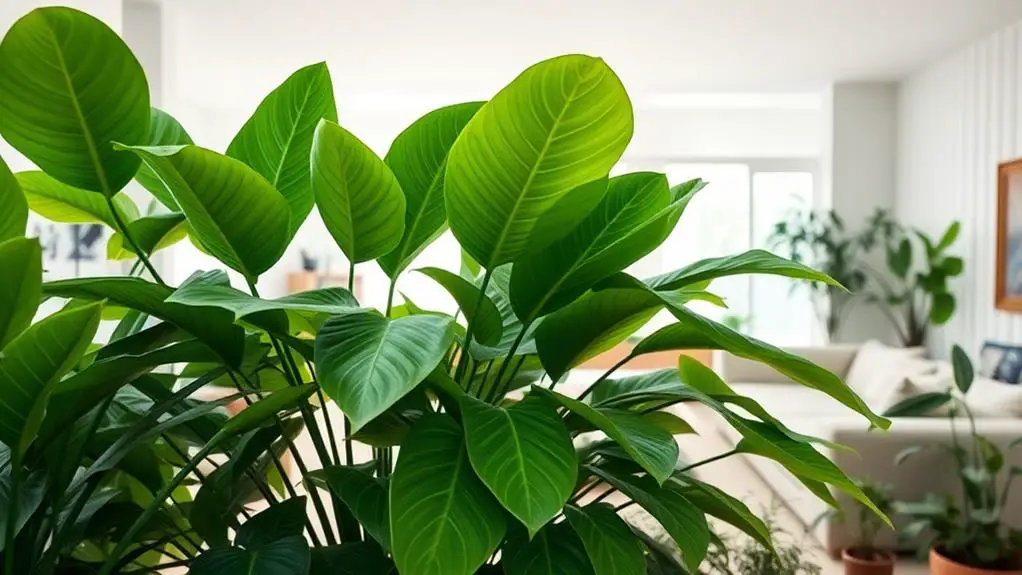
Giving your philodendron enough room to grow is essential for its health and visual appeal. Vining types, like the Pink Princess, benefit greatly from having ample space to explore. In their natural habitats, these plants climb or cascade, so mimicking this in your home will help them thrive.
Providing a support structure, such as a moss pole or trellis, encourages upward growth and adds to their beauty. When placed in hanging baskets, vining types can show off their trailing growth, creating a stunning visual effect in any room. Make certain that your philodendron has plenty of space to spread out. Overcrowding can lead to leggy growth and poor health.
Regularly check for signs of growth and adjust your plant's positioning or support. This guarantees your philodendron has the space it needs to flourish. Here's a quick guide to help you:
| Growth Habit | Support Structure | Visual Display |
|---|---|---|
| Climbing | Moss Pole | Upright, vertical |
| Cascading | Trellis | Spreading, horizontal |
| Trailing | Hanging Basket | Downward, flowing |
Repot When Necessary
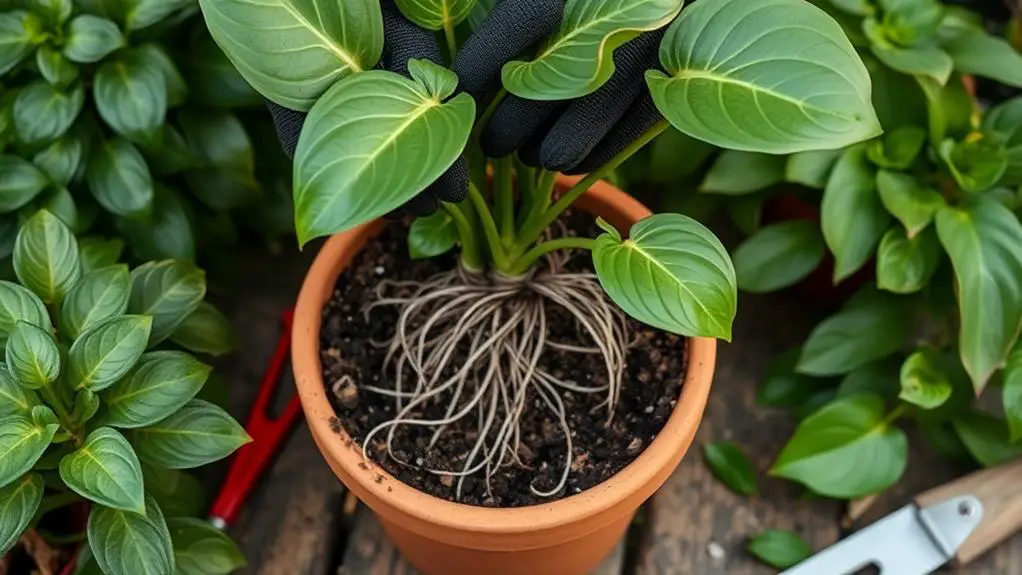
Repotting is crucial for your philodendron's health and growth. When roots become visible through the drainage holes or your plant shows stunted growth, it's time to repot. These signs indicate that your philodendron has become root bound and needs more space to thrive.
The best time to repot is during spring or early summer. This is when your plant is actively growing and can recover from the stress of repotting more effectively. Choose a pot that's one size larger than the current one. This will give your philodendron enough room to grow without risking overwatering.
Make certain to use a well-draining potting mix, preferably peat-based. This mix will help balance moisture and support healthy root development.
Regularly checking your philodendron's root system every 1-2 years is a good habit. This guarantees you can repot when necessary, refresh the soil, and provide crucial nutrients.
Repotting may seem intimidating, but it's an important part of caring for your philodendron. By following these steps, you'll help your plant continue to grow and thrive.
Frequently Asked Questions
How to Make Philodendron Thrive?
To make your Philodendron thrive, provide bright, indirect light and water when the top inch of soil is dry. Fertilize every 4-6 weeks, maintain 60% humidity, and repot every 1-2 years to encourage healthy growth.
How Do I Make My Philodendron Happier?
To make your Philodendron happier, give it bright, indirect light, water when the top inch of soil is dry, maintain humidity above 40%, and fertilize every 4-6 weeks. Prune damaged leaves regularly for peak health.
How to Encourage Philodendron Growth?
To encourage Philodendron growth, provide bright, indirect light and water when the top inch of soil is dry. Use well-draining soil, fertilize every 4-6 weeks, maintain 60% humidity, and prune regularly for bushier growth.
How to Properly Care for a Philodendron?
To properly care for a Philodendron, place it in bright, indirect light, water when the top inch is dry, use well-draining soil, keep humidity above 40%, and maintain temperatures between 65°F and 80°F. Inspect and prune regularly.
Conclusion
You've got this! By optimizing light, mastering watering, fertilizing wisely, giving your Philodendron space, and repotting when needed, you're setting your plant up for success. Remember, bright indirect light and regular rotation keep your plant happy. Check soil moisture before watering, and use room temperature water. Fertilize every 4-6 weeks in the growing season. Provide support structures and space for growth. Repot in spring with well-draining soil. Stick to these tips, and your Philodendron will thrive!

